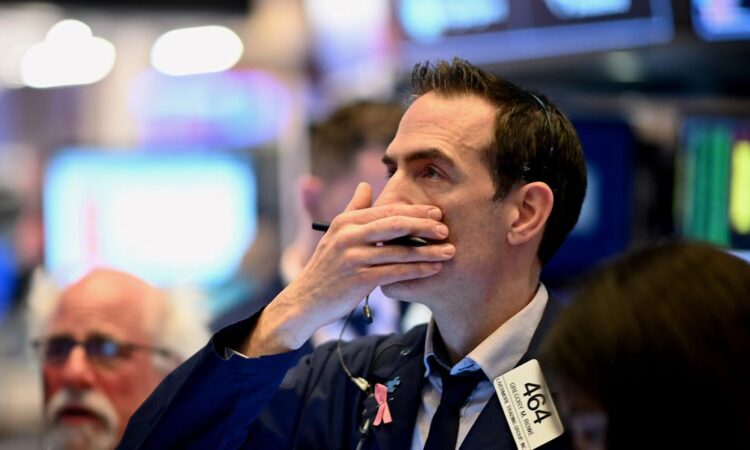
The so-called “Magnificent 7” — Amazon, Apple, Meta, Alphabet, Tesla, Nvidia, and Microsoft — almost singlehandedly lifted the S&P 500 to its 24% gain in 2023.
But the market’s saviors last year could be its downfall going forward, according to Jon Wolfenbarger, the founder of markets newsletter site BullAndBearProfits.com and a former investment banker at Merrill Lynch and JPMorgan.
ClearBridge Investments
In a January 22 note, Wolfenbarger compared the current environment to the dot-com bubble in the late 1990s and early 2000s, during which internet stocks fueled the market to stellar returns before crashing spectacularly.
“For those of you younger than us who did not live through the Tech Bubble of the late 1990s, you are now living through Tech Bubble 2.0. As a reminder, the NASDAQ fell about 80% when that bubble burst in the mild recession of the early 2000s,” Wolfenbarger said. “Given the fact that stock market valuations are even higher now than they were at the Tech Bubble peak of 2000, we would not be surprised by a similar decline in the coming recession.”
There is evidence that backs up Wolfenbarger’s bubble claims, starting with fairly standard valuation measures like the Shiller cyclically-adjusted price-to-earnings ratio. While it’s not as high as it was during the dot-com bubble, it’s higher than it was in 1929 — and is at one of its most elevated levels in history.
GuruFocus
Then there is concentration. The top five stocks today make up a much higher percentage of the S&P 500 than they did at the height of the dot-com bubble — making this a dangerously concentrated market at the best of times.
ClearBridge Investments
Bank of America’s Michael Hartnett has also labeled the AI boom as a “baby bubble,” as returns on the trade rise to 200% and continue to surge toward internet bubble levels.
Bank of America
About half of fund managers worldwide have also said that the “Magnificent 7” is the most crowded trade globally, according to Bank of America’s Global Fund Manager Survey.
“That means that despite their big run-up this past year — recovering from the huge drop in 2022 — investors are still expecting much more upside to come,” Wolfenbarger said of the survey results.
Bank of America
As for what will finally deflate the bubble, Wolfenbarger is expecting a recession to hit the US economy. He pointed to a few labor market indicators like a falling number of full-time employees and downward job gain revisions as evidence that the economic outlook will worsen.
The number of full-time employees fell sharply from November to December, and has been in a downtrend since June 2023. If the trend continues, the drop could quickly begin to look like it did in the 2001 and 2008 recessions.
St. Louis Fed
Wolfenbarger also highlighted job gain revisions, which are negative on a cumulative year-over-year basis by more than 300,000 jobs, resembling patterns seen in prior recessions. Still, job gains have remained positive despite downward revisions, and the unemployment rate is historically low at 3.7%.
ClearBridge Investments
Finally, he pointed to the Institute for Supply Management’s Manufacturing and Services Employment index, which has dipped deeply negative, usually meaning that unemployment will rise.
Bullandbearprofits.com/Trahan Macro Research
Wolfenbarger also points to recession indicators like The Conference Board’s Leading Economic Index and the inverted Treasury yield curve as evidence a downturn is coming.
The bigger picture
Wolfenbarger has some good company in his view that stocks are in a bubble. Investing legend Jeremy Grantham, who called the 2000 and 2008 crashes, has said since early 2022 that stocks are in a “super bubble.” He reiterated those views in an interview with Business Insider in December, and said that bubbles take their time to unfold.
Adam Karr, the president of Orbis Investment Management, also made this point in his 2023 president’s letter, noting that the bust of the dot-com bubble saw two rallies of 35% and 51%.
Orbis Investment Management
Karr cautioned investing in the “Magnificent 7” going forward despite their popularity.
“Collectively, the ‘Magnificent Seven’ added about $5 trillion in market capitalisation [in 2023] —roughly equivalent to the entire Japanese stock market. Some of these gains are justified by the superior fundamentals that these companies have produced—but there is a natural limit to how long it can continue at this staggering pace,” he wrote. “And to continue delivering attractive returns, they will need to add many more ‘Japans’ worth of market value in the years to come. Possible, but the odds don’t strike us as compelling.”
He continued: “Historically, similar periods have ended badly. Expensive stocks lost 40% of their value following the Japan bubble in the late 1980s and 50% of their value following the dot-com implosion. Investors can look foolish for not owning the winners in the short term—and ‘FOMO’ can be overwhelming. But paying too much for an asset with high expectations can be a recipe for disaster.”
Most Wall Street strategists also believe stocks will generally stagnate from here, if not fall slightly.
But on the recession front, Wolfenbarger’s view is now against consensus. According to Bank of America, 66% of Global Fund Manager Survey respondents see a soft landing ahead.
It’s still too early for investors and the Federal Reserve to declare victory on the recession front, as the central bank leaves rates elevated for the time being and the economy starts to show signs of slowing. For the time being, the economy has held up in the face of the most aggressive hiking regime in decades. Data in the months ahead will tell whether that strength continues or Wolfenbarger’s outlook proves correct.
